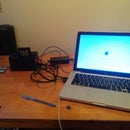Introduction: Dropped Screw Finder
Almost there! You've got the right angle your screw is aligned with the phone part you are trying to clamp together between your pinky of your left hand and the index of your friend's hand, and your friend sneezes sending your tiny phone screws on the floor and out of sight...
Ok, so maybe I don't fix my phones with the help of my friends, but I do drop screws all the time. They are ridiculously small so I can't see them even when I look like I'm smelling the hardwood... So, one morning I decided to make something that could help me find those screws again.
You will need...
Materials
- A piece of wood (2x4 inches and 1 inch deep)
- Part of a broom handle or hockey stick (length to your specification)
- A magnet, or magnet strips
- Screws or nails
Tools:
- A saw
- A screwdriver
- An angle cutter guide (optional)
- Cable cutter (or a tool strong enough to cut magnetic strips)
Step 1: Grab Your Materials
Find your materials!
For a project such as this I didn't need anything fancy, nor did it have to be specific to this project. It was originally a scrap parts project to help solve my missing screws problem fast and efficiently. Therefore there was no need for aesthetics to come into play.
From my pile of scrap wood and metals I grabbed part of a broom handle, and a rectangular piece of wood that would form a makeshift magnetic broom like thing. Also from a pile of old stuff I found my magnet strips I used to make one of those hovering - monorail like trains, just for the heck of it.
The screws as well were from assorted plastic containers I have laying around.
Step 2: Piecing the Structure Together
Using the angle cutting guide, I cut the broom handle at an angle of 45 degrees.
The cut itself being quite rough, I filed off the broken end trimmings so the handle would fit in more flush with the rectangular piece that will be holding the magnetic strips.
Once the handle and the head fit together nicely, or nicely enough that once screwed together there would be no gap in between the 2 pieces... I drilled a hole in the handle so it wouldn't split when the screw would go through it and then I screwed it directly into the piece of wood without a pre-drilled hole so it would hold tighter.
Now, it is time to flip it around!
Step 3: Adding the Magnetic Strips
Once the handle and the head were assembled, I cut the magnetic strips down to the right length.
I cut enough strips to cover the base of the head.
The type of magnetic strip that I had was adhesive on one side, but as you can tell from the last picture, it wasn't strong enough. I also didn't take the time to prep the wood for the adhesive.
After I completed this, I did add some more glue and clamped the strip to the head until the glue set, and it worked.
That's basically it!
Step 4: The Tool in Action
Here are the pictures of it I took while testing it and using it. I hope this inspires you to make something better!













